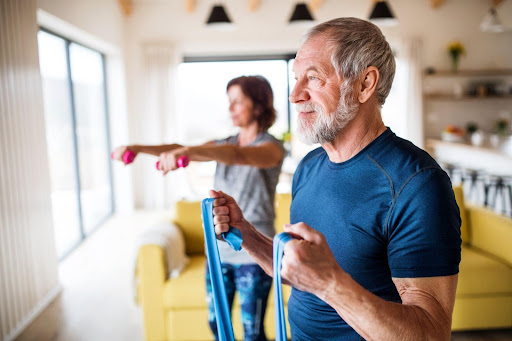When you’re young, getting enough exercise is trivial. You’re full of so much energy that you can simply jump out of bed and go for a run or a walk without thinking twice. However, as you age, this becomes more difficult. Your muscles and joints don’t do what you want them to as easily as they used to, and your life becomes busier and more difficult to manage, making it harder to fit in exercise. However, doing so has tangible health benefits.
Here are 9 tips for staying active as you get older.
1. Don’t push yourself
Perhaps the most important piece of exercise advice we can give you if you’re a little older is this: don’t push yourself. Don’t try to do what you could easily have done when you were twenty years younger; your body will have changed, even if you keep as fit as possible, so what you can do changes as you age. Make sure to keep your exercise routine proportionate to your age, your physical fitness level, and what it feels like you can manage reasonably comfortably.
2. Keep your muscles limber
You may find that as you get older, your muscles seize up more often than they used to. There’s also a possibility that your muscles will be much more sore than when you were younger, meaning longer recovery times until the next workout. At times like this, it can be a good idea to use exercise tech to keep yourself limber. Sites like https://bestmassageguns.co.uk/ are a good place to go if you want to get a massage gun, which can help you maintain good muscle health if used correctly.
3. Start by walking
If you’re new to exercise, then one of the best things you can do as you age is to walk instead of running. You may not think the health benefits are as obvious, but walking can actually be a great form of exercise that helps to keep you in shape. Even walking thirty minutes per day can have a greatly positive effect on your overall health, and it’s not just physical benefits you’ll notice, either; you’ll also see a boost to your mental health if you walk.
4. Lift weights
One of the ways that your body changes as you age is muscle definition. You often lose muscle definition as you get older, simply because every part of our body is technically atrophying all the time. That’s why it’s important to lift weights and keep your muscles toned. You don’t need to bench-press or do anything drastic; just lifting a small weight regularly can keep your muscles looking and feeling great. It’s not so much about power as it is about consistency, as is the case with most physical (and mental) exercise.
5. Set a regular workout schedule
If you want to see tangible results from your physical workouts, then it’s important to set a good workout schedule. If you can find time to work out once per day, that’s great; if not, four or even three times per week will improve your fitness exponentially, especially if you currently don’t do any exercise at all. While it’s important to target specific muscle groups, you should also make sure you set aside time for overall cardio strength, because a healthy heart is even more crucial when you’re older.
6. Buy some home gym equipment
Many older folks don’t feel comfortable setting foot in a gym. They think that gyms are environments created solely for powerlifters and bodybuilders. While this isn’t necessarily true, it’s understandable if you don’t have the confidence to exercise around other people. In this instance, it’s a good idea to pick up some home gym equipment if you’ve got the space for it. A treadmill or a cross-trainer will work wonders for your cardio, and a small, simple set of weights is all you need to get started with strength training.
7. Consider yoga
As a low-impact form of exercise, yoga is an excellent way to keep fit when you’re older. You don’t need anything other than a mat and the right attitude to start doing yoga. There are also lots of beginner courses available for those who aren’t yet familiar with the basics. If you feel like yoga is off-putting or intimidating, don’t; just find yourself a YouTube tutorial that you’re comfortable with and start from there. You can move on to more advanced poses later, if you feel like it.
8. Buy a bike
One of the best ways to make small, tangible improvements to your fitness is to cycle instead of taking public transport. If you’re fit enough and your heart is healthy enough, why not cycle to the shops? It may only be a five-minute journey, but the benefits to your health will become obvious as you rack up those miles. If you start to feel more confident, you can expand your routine and cycle further. Cycling is a good way to keep fit, especially now that many cities are building up their cycling infrastructure!
9. Don’t compare yourself
Theodore Roosevelt once called comparison “the thief of joy”, and exercise is one area in which it’s easy to see what he meant. If you compare yourself to others, you’ll only start worrying about all the ways you might not measure up. Everyone’s exercise journey is different, and everyone has different goals. For you, a victory will look very different than it would for someone else, so don’t compare yourself to others; focus on yourself and what you want to achieve when you’re exercising.
























